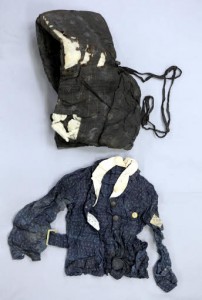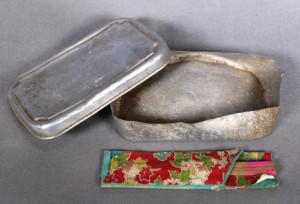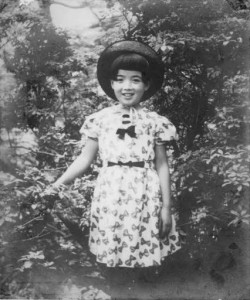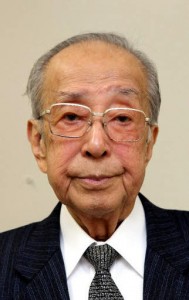Silent witness: Belongings of A-bomb victim, girl who authored well-known diary during the war, to be donated to Peace Memorial Museum
Jan. 9, 2018
by Yumi Kanazaki, Staff Writer
Yoko Moriwaki, who was 13 years old at the time of the atomic bombing of Hiroshima and a first-year student at First Hiroshima Prefectural Girls’ High School (now Minami High School), is known for having kept a diary of her active life until the day before the bombing. Her diary now stands as a symbol of the cruelty of the atomic bomb. Her brother, Koji Hosokawa, 90, an A-bomb survivor who lives in Naka Ward, donated her uniform, air raid hood, and misshapen lunch box to the Peace Memorial Museum. Mr. Hosokawa has long safeguarded these mementos at his home as reminders of his sister’s life. Given his advancing age, he has now decided to take the further step of ensuring that these precious items will be kept safe and secure in the possession of the museum for many more years to come.
On August 6, 1945, at the moment the atomic bomb was dropped on Hiroshima, Yoko was helping to dismantle buildings to create a fire break in Dobashi-cho (now part of Naka Ward), about 700 meters from the hypocenter. She was severely burned by the atomic bomb and died that same night. A total of 301 students and teachers from First Hiroshima Prefectural Girls’ High School lost their lives in the A-bomb attack.
Yoko made her school uniform herself, by hand, using cloth from her mother’s kimono. Patches that bear her name and the words “Student Corps” were sewn onto the uniform. It is thought that Yoko changed from her school uniform into her work clothes at the building demolition site, thus saving her school uniform and air raid hood from being burned black and they were later found and passed on to her family by staff from her school.
Yoko’s misshapen lunch box was found by Mr. Hosokawa himself near the building demolition site with her chopstick pouch, lying nearby, serving as a clue.
Mr. Hosokawa published the book Yoko Moriwaki’s Diary in 1996, which is still read today. The diary consists of entries she made from the time she entered the girls’ high school until August 5, the day before the atomic bombing, and its final words were “Tomorrow I’ll help clean up at the building demolition site. I will work as hard as I can.” This diary and the fountain pen with which she wrote the entries, which Mr. Hosokawa still keeps, were introduced in a textbook for junior high school students. Four years ago, her diary was also published in English, in Australia, and has generated a strong response.
When the atomic bomb exploded, Mr. Hosokawa was about 1.3 kilometers from the hypocenter and he managed to survive. He has served as a Peace Volunteer, guiding visitors through the Peace Memorial Museum, and has shared his own A-bomb account with others. In addition, he has dedicated himself to training the “memory keepers” who are inheriting the A-bomb survivors’ experiences and memories. Through this work, Mr. Hosokawa has learned about the belongings of the A-bomb victims and how they silently convey the cruelty of the atomic bomb, the chagrin of the victims, and the grief and sorrow felt by the bereaved families. Now, 72 years after the atomic bombing, he has finally decided to donate his sister’s belongings to the museum, despite hesitating to do so for many years because of the value they hold to him.
A historic year, which marked the establishment of the Treaty on the Prohibition of Nuclear Weapons, is about to end, and the new year will see an increasing number of visitors to Hiroshima from both in and out of Japan. Mr. Hosokawa said, “For us, the belongings of the A-bomb victims are not merely objects; they embrace the spirits of both the A-bomb victims and the people who value and cherish them. I hope that my sister’s possessions will remain etched in the memories of every visitor when they are exhibited at the museum.”
(Originally published on December 31, 2017)
Yoko Moriwaki, who was 13 years old at the time of the atomic bombing of Hiroshima and a first-year student at First Hiroshima Prefectural Girls’ High School (now Minami High School), is known for having kept a diary of her active life until the day before the bombing. Her diary now stands as a symbol of the cruelty of the atomic bomb. Her brother, Koji Hosokawa, 90, an A-bomb survivor who lives in Naka Ward, donated her uniform, air raid hood, and misshapen lunch box to the Peace Memorial Museum. Mr. Hosokawa has long safeguarded these mementos at his home as reminders of his sister’s life. Given his advancing age, he has now decided to take the further step of ensuring that these precious items will be kept safe and secure in the possession of the museum for many more years to come.
On August 6, 1945, at the moment the atomic bomb was dropped on Hiroshima, Yoko was helping to dismantle buildings to create a fire break in Dobashi-cho (now part of Naka Ward), about 700 meters from the hypocenter. She was severely burned by the atomic bomb and died that same night. A total of 301 students and teachers from First Hiroshima Prefectural Girls’ High School lost their lives in the A-bomb attack.
Yoko made her school uniform herself, by hand, using cloth from her mother’s kimono. Patches that bear her name and the words “Student Corps” were sewn onto the uniform. It is thought that Yoko changed from her school uniform into her work clothes at the building demolition site, thus saving her school uniform and air raid hood from being burned black and they were later found and passed on to her family by staff from her school.
Yoko’s misshapen lunch box was found by Mr. Hosokawa himself near the building demolition site with her chopstick pouch, lying nearby, serving as a clue.
Mr. Hosokawa published the book Yoko Moriwaki’s Diary in 1996, which is still read today. The diary consists of entries she made from the time she entered the girls’ high school until August 5, the day before the atomic bombing, and its final words were “Tomorrow I’ll help clean up at the building demolition site. I will work as hard as I can.” This diary and the fountain pen with which she wrote the entries, which Mr. Hosokawa still keeps, were introduced in a textbook for junior high school students. Four years ago, her diary was also published in English, in Australia, and has generated a strong response.
When the atomic bomb exploded, Mr. Hosokawa was about 1.3 kilometers from the hypocenter and he managed to survive. He has served as a Peace Volunteer, guiding visitors through the Peace Memorial Museum, and has shared his own A-bomb account with others. In addition, he has dedicated himself to training the “memory keepers” who are inheriting the A-bomb survivors’ experiences and memories. Through this work, Mr. Hosokawa has learned about the belongings of the A-bomb victims and how they silently convey the cruelty of the atomic bomb, the chagrin of the victims, and the grief and sorrow felt by the bereaved families. Now, 72 years after the atomic bombing, he has finally decided to donate his sister’s belongings to the museum, despite hesitating to do so for many years because of the value they hold to him.
A historic year, which marked the establishment of the Treaty on the Prohibition of Nuclear Weapons, is about to end, and the new year will see an increasing number of visitors to Hiroshima from both in and out of Japan. Mr. Hosokawa said, “For us, the belongings of the A-bomb victims are not merely objects; they embrace the spirits of both the A-bomb victims and the people who value and cherish them. I hope that my sister’s possessions will remain etched in the memories of every visitor when they are exhibited at the museum.”
(Originally published on December 31, 2017)











